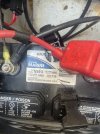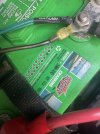- Joined
- Jun 4, 2020
- Messages
- 2,945
- Reaction score
- 775
- Points
- 113
- Age
- 39
- Location
- Seattle
- Model
- Seafarer
I bought my 2004 GW 228 Seafarer in October of 2021, have fished her for two seasons now without so much as a hiccup, but yesterday while I was fishing I got a "low voltage alarm" notification on my Garmin unit. Today, I planned on bringing the boat in off the buoy for the winter and get her all cleaned up, so I paddled out and tried to start her up but the battery was dead enough to not be able to start. I threw the jump pack on the "starting battery", selected the "1" position on the battery switch so that it was just using the one battery to start the motor and not be potentially drained down by the other battery, if that was the problematic one. Still couldn't get her to start, and I even tried a couple different combos with the battery switch, such as leaving it in the "all" or "both" position, which is what I was told from the dealership to do. Anyway, both batteries appear to be Group 24's and there is one "starting battery" and one "cranking battery", of which I'm assuming that the "starting battery" is the one that starts the motor? Both "starting battery" and "cranking battery" sound almost synonymous to me, but I don't know very much about marine batteries. The other question that I have is that the "starting battery" doesn't have a manufacturers date on it, but the "cranking battery" does, which it shows a "3" that is punched out of the sticker, although the months are abbreviated below and none of those are punched out. Is it possible the "3" on it is for the year and was last replaced in 2013? If so, that's rather impressive, though as stated above I bought the boat used and I have no idea when the batteries were last replaced. I haven't done anything to the batteries or really much to the boat since purchasing her in October of 2021, except a new GPS, so the "3" definitely isn't 2023 or anything. Anyway, should I replace the batteries exactly how they are with buying one "starting battery" and one "cranking battery"? They've got them at Costco for about $80 a piece and figure I should just replace both at the same time, since both are a bit uncertain in regards to age at this point. Thanks in advance!





